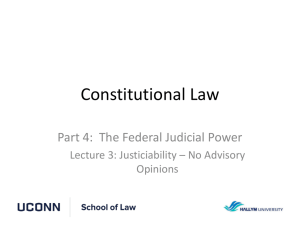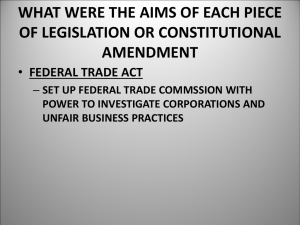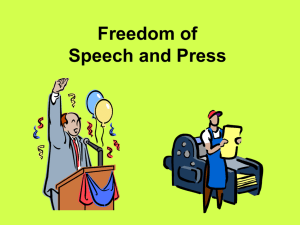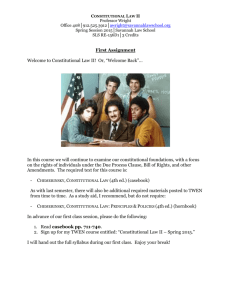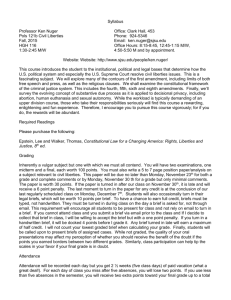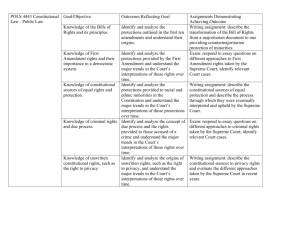Part 8, Lecture 2
advertisement
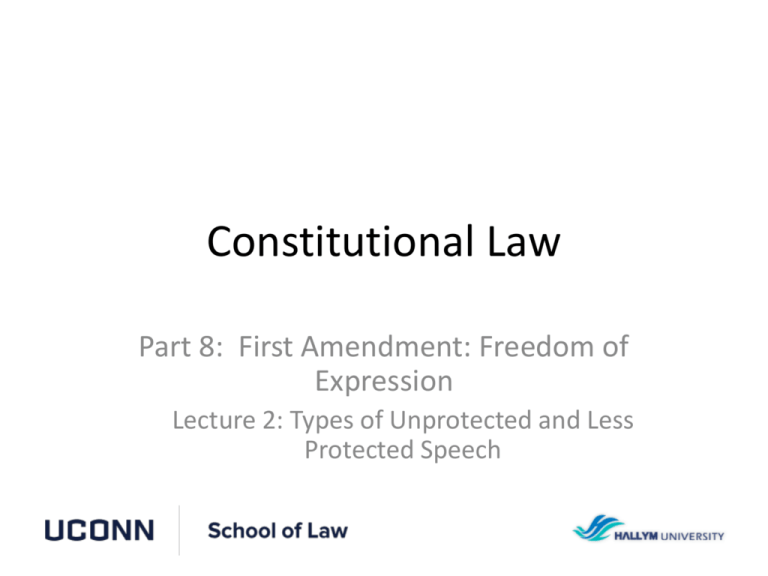
Constitutional Law Part 8: First Amendment: Freedom of Expression Lecture 2: Types of Unprotected and Less Protected Speech Types of Unprotected and Less Protected Speech • The Supreme Court has identified some categories of unprotected and less protected speech where the government has more latitude to regulate than usual under the First Amendment. 1. 2. 3. 4. 5. 6. Incitement of illegal activity – advocates illegal acts or the overthrow of the government (Schenck v. United States) Fighting words – speech that is directed at another and likely to provoke a violent response (Chaplinsky v. New Hampshire) Obscenity – material which deals with sex in a manner appealing to the indecent interest (Miller v. California) Commercial speech – expression related solely to the economic interests of the speaker and its audience. (Central Hudson. v. Public Service Commission) Defamatory speech –speech that is injures reputation (New York Times Co. v. Sullivan) Symbolic speech – conduct that communicates through symbols (such as flag burning) rather than words (United States v. O’Brien) Constitutional Law – Professor David Thaw Part 8 Lecture 2 Slide 2 Justification for Different Treatment • These categories are defined based on the subject matter of the speech and thus represent an exception to the usual rule that content-based regulation must meet strict scrutiny. – The categories of unprotected and less protected speech reflect value judgments by the Supreme Court that the justifications for regulating such speech outweigh the value of the expression. Constitutional Law – Professor David Thaw Part 8 Lecture 2 Slide 3 Schenck v. United States (1919) Background: • Schenck was convicted for circulating a leaflet arguing that the draft violated the Thirteenth Amendment as a form of involuntary servitude. – The leaflet said, “Do not submit to intimidation,” and “Assert Your Rights,” but did not expressly urge violation of any law; it advocated repealing the draft law. – There was not any evidence that the leaflet had any effect in causing a single person to resist the draft. Constitutional Law – Professor David Thaw Part 8 Lecture 2 Slide 4 Schenck v. United States Issue: Does the content of the leaflet create a clear and present danger sufficient to constitute incitement to illegal activity? • The fact that the leaflet had not had any actual effect was not relevant – it only mattered that the leaflet was intended to have an effect. – “Of course the document would not have been sent unless it had been intended to have some effect, and we do not see what effect it could be expected to have upon persons subject to the draft except to influence them to obstruct the carrying of it out.” Constitutional Law – Professor David Thaw Part 8 Lecture 2 Slide 5 Schenck v. United States Holding: The words contained in the leaflet fall into the unprotected category of incitement to illegal activity, and therefore there was no violation of Schenck’s First Amendment rights. • The Court said that although in “many places and in ordinary times” the speech would have been protected by the First Amendment, the wartime circumstances were crucial. – “But the character of every act depends upon the circumstances in which it is done. The most stringent protection of free speech would not protect a man in falsely shouting fire in a theatre, and causing a panic. . . . The question in every case is whether the words used are used in such circumstances and are of such a nature as to create a clear and present danger that they will bring about the substantive evils that Congress has a right to prevent.” (CB 1308) Constitutional Law – Professor David Thaw Part 8 Lecture 2 Slide 6 Chaplinsky v. New Hampshire (1942) Background • A New Hampshire statute prohibited any person on a street or public place from calling another person a derisive name or directing to another person an offensive, derisive, or annoying statement. • Chaplinsky called a City Marshal a “God damned racketeer” and a “damned fascist” in a public place and was arrested and convicted under the statute. Constitutional Law – Professor David Thaw Part 8 Lecture 2 Slide 7 Chaplinsky v. New Hampshire Issue: Does the statute or the application of the statute to Chaplinsky’s words violate his free speech rights under the First Amendment of the Constitution? • The Court said that “[a]llowing the broadest scope to the language and purpose of the Fourteenth Amendment, it is well understood that the right of free speech is not absolute at all times and under all circumstances . . . These include the . . . insulting or fighting words — those which by their very utterance inflict injury or tend to incite an immediate breach of the peace.” (CB 1339) Constitutional Law – Professor David Thaw Part 8 Lecture 2 Slide 8 Chaplinsky v. New Hampshire Holding: The statute at issue is narrowly drawn to define and punish fighting words, therefore it does not unconstitutionally infringe the right of free speech. • Fighting words do not deserve constitutional protection because they “are no essential part of any exposition of ideas, and are of such slight social value as a step to truth that any benefit that may be derived from them is clearly outweighed by the social interest in order and morality.” (CB 1339) • There are two situations where speech constitutes fighting words: 1. 2. Where it is likely to cause a violent response against the speaker. Where it is an insult likely to inflict immediate emotional harm. Constitutional Law – Professor David Thaw Part 8 Lecture 2 Slide 9 Miller v. California (1973) Background: • Miller conducted a mass mailing campaign to advertise the sale of illustrated adult material books. The mailed brochures consisted primarily of pictures and drawings explicitly depicting men and women engaging in a variety of sexual activities. • Miller was convicted of distributing obscene matter in violation of California criminal law. Constitutional Law – Professor David Thaw Part 8 Lecture 2 Slide 10 Miller v. California Issue: Did the mailings contain obscene material that may be properly criminalized under state statute without violating First Amendment rights? • The Supreme Court had previously recognized that there were legitimate state interests in prohibiting or regulating obscenity, but struggled to define what was regulable obscene material. Constitutional Law – Professor David Thaw Part 8 Lecture 2 Slide 11 Miller v. California Holding: The mailings were obscene and could be regulated by the state because they appealed to the prurient interest, were patently offensive, and lacked serious literary, artistic, political or scientific value. • The Court articulated the test for when material would be considered obscene: 1. 2. 3. Whether ‘the average person, applying contemporary community standards’ would find that the work, taken as a whole, appeals to the prurient interest; Whether the work depicts or describes, in a patently offensive way, sexual conduct specifically defined by the applicable state law Whether the work, taken as a whole, lacks serious literary, artistic, political or scientific value. Constitutional Law – Professor David Thaw Part 8 Lecture 2 Slide 12 Central Hudson Gas & Electric Corp. v. Public Service Commission of New York (1980) Background: • The Public Service Commission ordered all electric companies to stop advertising the use of electricity. – The state determined that it did not have enough fuel to last the winter and needed citizens to conserve. • Once the shortage was over, the Central Hudson Gas & Electric Corp. opposed the ban on First Amendment constitutional grounds. Constitutional Law – Professor David Thaw Part 8 Lecture 2 Slide 13 Central Hudson v. Public Service Commission Issue: Does the regulation that bans promotional advertising electric utility companies violate the First Amendment? • Advertising a product or service is expressly within the definition of commercial speech – the Supreme Court had previously held that commercial speech was entitled to at least some protection under the First Amendment. Constitutional Law – Professor David Thaw Part 8 Lecture 2 Slide 14 Central Hudson v. Public Service Commission Holding: The ban is unconstitutional even though the Constitution accords a lesser protection to commercial speech than to other constitutionally guaranteed expression under the First Amendment. • The Court expressly said that “[t]he Constitution [] accords a lesser protection to commercial speech than to other constitutionally guaranteed expression.” (CB 1436) – There is a “commonsense distinction between speech proposing a commercial transaction, which occurs in an area traditionally subject to governmental regulation, and other varieties of speech.’” (CB 1436) Constitutional Law – Professor David Thaw Part 8 Lecture 2 Slide 15 Central Hudson v. Public Service Commission • The Court articulated four-part analysis for analyzing government regulation of commercial speech: 1. Is the advertising false or deceptive or of illegal activities, areas which are unprotected by the First Amendment 2. Is the government’s restriction justified by a substantial government interest? 3. Does the law directly advance the government’s interest? 4. Is the regulation of speech no more extensive than necessary to achieve the government’s interest? • The government has the burden of proof to demonstrate that the Central Hudson test is met in order to justify a restriction on commercial speech. Constitutional Law – Professor David Thaw Part 8 Lecture 2 Slide 16 Central Hudson v. Public Service Commission • The Court applied the test to the New York law: 1. The utility’s advertisements were truthful and not deceptive. 2. The government had a substantial interest in discouraging energy consumption. 3. Prohibiting advertising by the utility directly advanced the state’s interest in energy conservation. 4. The state could achieve its goal of encouraging energy conservation through means less restrictive of speech. • Because the law failed the fourth prong of the test, the Court found it unconstitutional. Constitutional Law – Professor David Thaw Part 8 Lecture 2 Slide 17 New York Times Co. v. Sullivan (1964) Background • The New York Times carried a full-page advertisement that contained several paragraphs describing unfair treatment of protestors who mentioned unfair treatment by the police. • Sullivan was a commissioner who supervised the city police department. Although none of the statements made within the advertisement directly named Sullivan, he argued that, as supervisor of the city police department, he was being accused of allowing the described treatment of the students. – It was found that some of the statements contained in the advertisement were not accurate descriptions of what had actually occurred and placed the police department in a very unfavorable light. • Sullivan brought a defamation claim against the New York Times for publishing the advertisement. Constitutional Law – Professor David Thaw Part 8 Lecture 2 Slide 18 New York Times Co. v. Sullivan Issue: Is the New York Times liable for defamation for printing an advertisement, which criticized a public official’s official conduct? • The Court said the case must be considered “against the background of a profound national commitment to the principle that debate on public issues should be uninhibited, robust, and wide-open, and that it may well include vehement, caustic, and sometimes unpleasantly sharp attacks on government and public officials.” (CB 1463) – The Court explained that criticism of government and government officials was at the core of speech protected by the First Amendment. Constitutional Law – Professor David Thaw Part 8 Lecture 2 Slide 19 New York Times Co. v. Sullivan Holding: The First Amendment limits the ability of the government to impose liability for defamation by requiring a showing of actual malice, which is not met on these facts. • Public officials can recover for defamation only by proving with clear and convincing evidence the falsity of the statements and actual malice. – Actual malice means that the defendant knew that the statement was false or acted with reckless disregard of the truth. • The fact that some of the statements were false was not sufficient to deny the speech of protection. – False “statement is inevitable in free debate and must be protected if the freedoms of expression are to have the ‘breathing space’ that they ‘need . . . to survive.’” (CB 1464) Constitutional Law – Professor David Thaw Part 8 Lecture 2 Slide 20 United States v. O’Brien (1968) Background • The Universal Military Training and Service Act made it an offense to “alter, knowingly destroy, knowingly mutilate” a draft card. • O’Brien knowingly burned his draft card on the front steps of the local courthouse and claimed it was an exercise of free speech. Constitutional Law – Professor David Thaw Part 8 Lecture 2 Slide 21 United States v. O’Brien Issue: Is the Act unconstitutional as applied to O’Brien because his act of burning the draft card was protected “symbolic speech” within the First Amendment? • The Court said that “when ‘speech’ and ‘nonspeech’ elements are combined in the same course of conduct, a sufficiently important governmental interest in regulating the nonspeech element can justify incidental limits on First Amendment freedoms.” (CB 1492) Constitutional Law – Professor David Thaw Part 8 Lecture 2 Slide 22 United States v. O’Brien Holding: The Act is constitutional because the governmental interest in preserving draft cards outweighed the individual interest in the symbolic speech. • The Court then articulated a test for evaluating symbolic speech: • It must be within the constitutional power of the Government; • further an important or substantial governmental interest; • the governmental interest must be unrelated to the suppression of free expression; and • the incidental restriction on First Amendment freedoms must be no greater than is essential to the furtherance of that interest. Constitutional Law – Professor David Thaw Part 8 Lecture 2 Slide 23 United States v. O’Brien • The Court found that this test was met in the government’s prohibition of draft card burning. – The Court identified several justifications, unrelated to suppression of speech, for the prohibition of draft card destruction or mutilation. – For example, requiring the presence of draft cards facilitates emergency military mobilization, aids communication with a person’s draft board because the address is listed on the card, and reminds individuals to notify their draft board of any change in address or changes related to draft status. Constitutional Law – Professor David Thaw Part 8 Lecture 2 Slide 24

